If you use coconut milk only from time to time, you’ve undoubtedly asked yourself: can you freeze coconut milk?
Avid consumers of nut milks don’t care about freezing them because they use them way before they goes bad. But if you rarely drink or use coconut milk, an entire carton might be too much for you to use before it goes bad. That’s when you start thinking about freezing the leftovers.
Same thing if you’re buying canned coconut milk for curries and other recipes native to Thai or Indian cuisine. For some reason, the amount in a single can and what the recipe calls for never match, so you’re left with a third or fourth of a cup. And if curries aren’t on your menu every other day (chances are they aren’t), you need to do something with the leftover milk. And since open canned coconut milk doesn’t last particularly long, freezing is the obvious option.
Unfortunately, there isn’t a simple yes or no answer to the question of whether you can freeze this product. It depends on how you want to use it and what are your standards when it comes to quality. In short: it’s complicated.
In this guide, we go through everything you need to know about freezing coconut milk. We discuss when freezing makes sense, and how to do it. We also cover thawing and refreezing, in case you have some leftovers after defrosting.
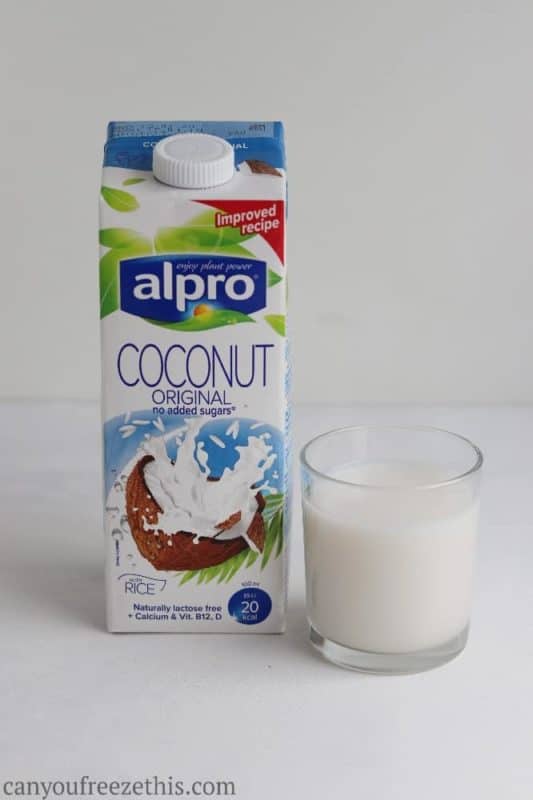
Can You Freeze Coconut Milk?
Answering this question is difficult. For both the beverage and the fatty canned version used for cooking, the manufacturers do not recommend (SI) freezing the product. That’s because freezing and thawing changes the texture and arguably taste of it. Despite that, many people freeze it anyway and are quite happy about the results.
Freezing and thawing coconut milk changes its texture, and the taste changes somewhat. The solids separate from liquids, and the liquid becomes grainy. Coconut milk drink right after thawing looks like this:
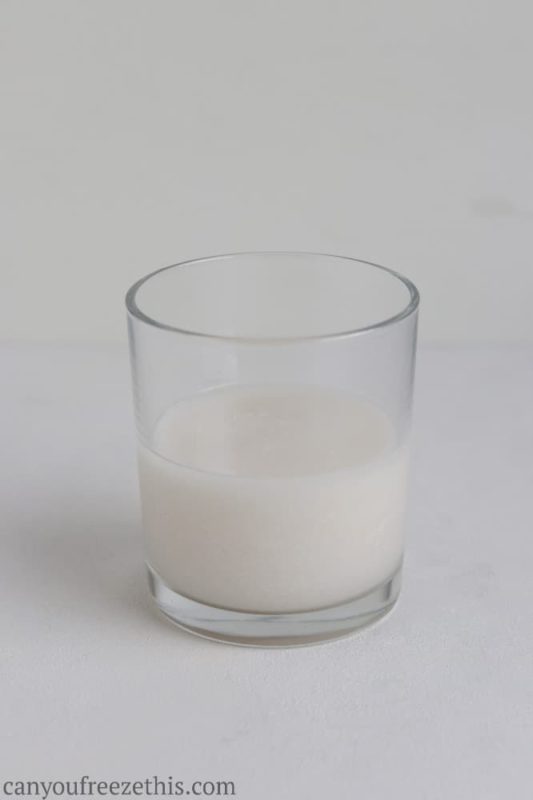
Yes, it doesn’t look that bad, and it looks much better than thawed almond milk. But it’s still a far cry from the smooth texture of fresh coconut milk.
Fortunately, most of the texture change can be fixed by running the defrosted liquid through a blender. After blending, the drink looks like this:
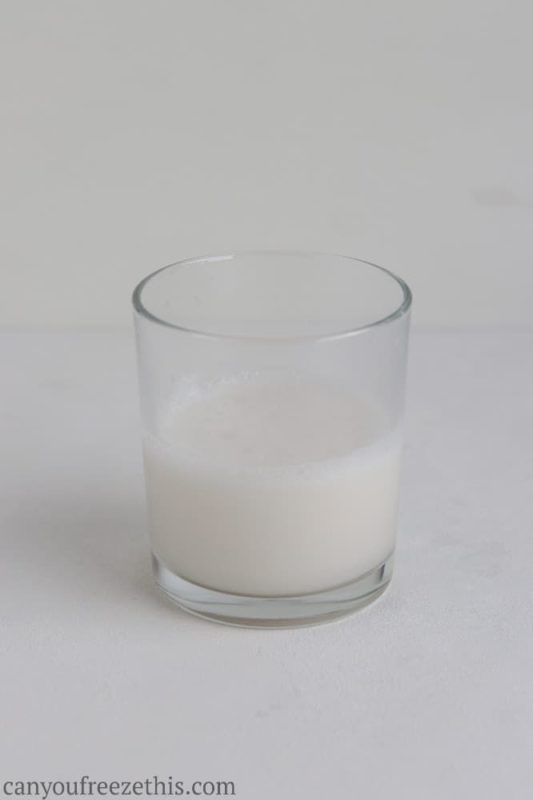
And here are all the three options side by side:
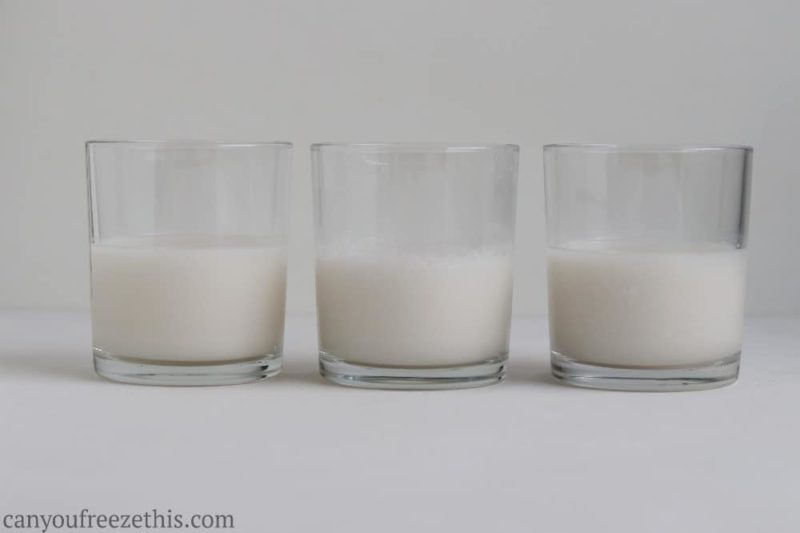
As you can probably see, blended and fresh don’t look that different, except for the foam on top. Plus the taste is arguably somewhat different (I’ll leave it at that, as it’s difficult to describe).
I found drinking the blended variety straight from the glass was alright. If fresh coconut milk would be a 10 in terms of taste and texture, I’d say the thawed and blended one was a 7, maybe even 8. Obviously, those are just my personal feelings.
Coconut milk from various brands freeze a bit differently so that you might be more or less fond of your favorite brand. If you need to freeze coconut milk often, consider testing a couple of brands and sticking with the one that gives you the best results.
So you already know that freezing this nut milk for drinking straight from the glass is iffy. Fortunately, you can use coconut milk in a variety of ways, like smoothies, baking, cooking, or as a coffee whitener. And in all of those cases, the slight change in texture and taste don’t make that much of a difference in the end product. So if you’re using it for one of those purposes, feel free to freeze this.
Can You Freeze Canned Coconut Milk?
Since an unopened can of coconut milk lasts years, there’s no need to freeze the whole thing. But if you used however much you needed for that curry or Tom Kha soup, and you have some leftovers with no clear plan of using in the next couple of days, freezing seems to be the best option.
Everything I wrote above about the coconut milk drink is true for the canned variety. Freezing and thawing alters the texture, but you can fix this by blending it together before using (CI).
Freezing Coconut Milk
Below I go through two ways of freezing coconut milk. If you don’t have any set plans on how you’re going to use it, go with the cubes. This method is more versatile, as it allows you to thaw as much as you need easily. It takes a couple more minutes of active time, though.
If, on the other hand, you know precisely how you will use that frozen and thawed milk, consider freezing it in containers. The freezing process is super simple, and once you defrost the contents of the container, it’s ready to go.
No matter if you’re dealing with coconut milk drink or the canned variety, both freezing methods are an option.
How to Freeze Coconut Milk in Cubes
This method is perfect if you don’t want to worry about the portion size. It takes a bit more effort, but in most cases, it’s totally worth it. Here’s how you can do it:
- Prepare the ice cube trays. You can use ice cube bags if you like, but the trays are reusable and more environment-friendly. Go with trays if you can.
- Pour the coconut milk into the trays.
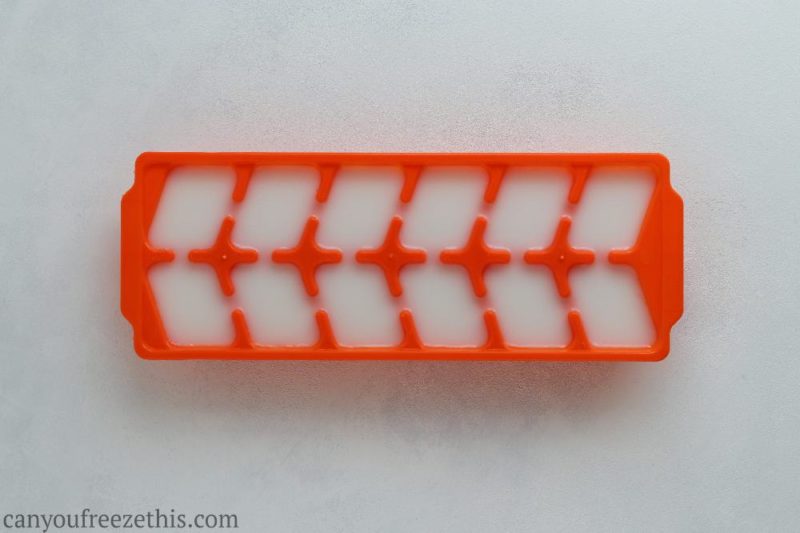
Coconut milk in an ice cube tray - Transfer the trays into the freezer and keep there until coconut milk cubes are frozen. It will take at least 3 to 5 hours for the cubes to freeze, depending on the size. Remember that the top of each cube will freeze quickly, but that doesn’t mean the liquid underneath has frozen too. I, to be safe, tend to leave the trays in the freezer overnight.
- Transfer the cubes to freezer bags or containers. Try to do this as fast as you can. This way, the cubes won’t start to thaw. Of course, you can leave the trays in the freezer, but it’s usually more convenient to throw the cubes into a container and have the trays ready for freezing another batch.
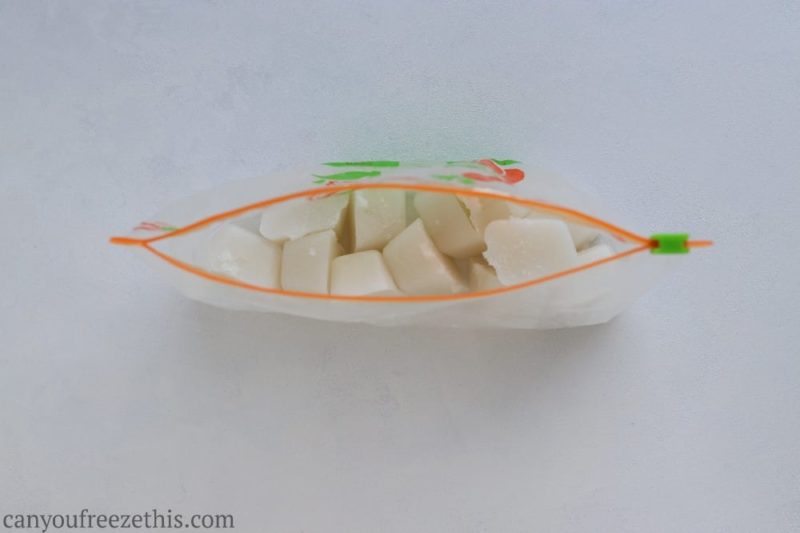
Frozen cubes of coconut milk - Put the bags or containers into the freezer.
Now you can easily scoop a few cubes to add to your recipe or thaw a bunch of them for a smoothie.
How to Freeze Coconut Milk in Containers
This method requires little time and effort. It’s best to know how much coconut milk you will need to thaw at a time so you can portion the liquid accordingly. If you’re uncertain, go for smaller portions, like half a cup or even a quarter. Or simply freeze coconut milk in cubes so you don’t have to worry about portion size and leftovers after thawing.
Once you have the portions figured out, here’s how to go about freezing:
- Pour the milk into containers. Make sure to leave some head-space, as the milk will expand when freezing. It’s fine to freeze coconut milk in the carton it came in, given that it’s not full.
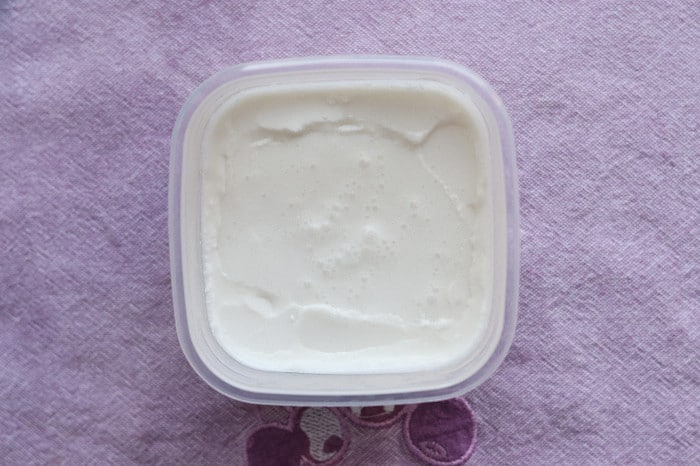
Canned coconut milk in a container - Label the containers with name and date if needed.
- Put the containers into the freezer.
That’s it. The whole process shouldn’t take more than a few minutes. Once the liquid freezes, it looks like this:
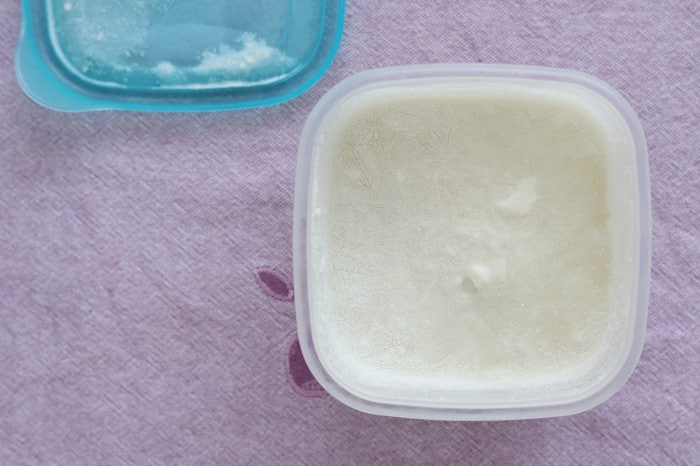
How to Thaw Coconut Milk?
There are at least a few ways you can defrost coconut milk.
- Overnight in the fridge. The classic: transfer the cubes or containers you want to thaw into the refrigerator in the evening, they will be thawed in the morning. If the cubes are quite large, defrosting might take longer, so plan accordingly and start the process even earlier.
- In cold water. Put the container or freezer bag in cold water. It should be ready in a couple of hours.
- Microwave. If you’re in a hurry, the microwave is probably the way to go. Defrost it in small increments and stir between each session once it starts to defrost.
- Throw it in frozen. If you need coconut milk for a cooked recipe (like a soup), you can throw it in frozen. Make sure to add a few minutes of cooking time to account for thawing and cooking the liquid. No matter the method you choose, make sure to give the thawed coconut milk a good stir, or better yet, run it through with a hand blender. That will improve its consistency.
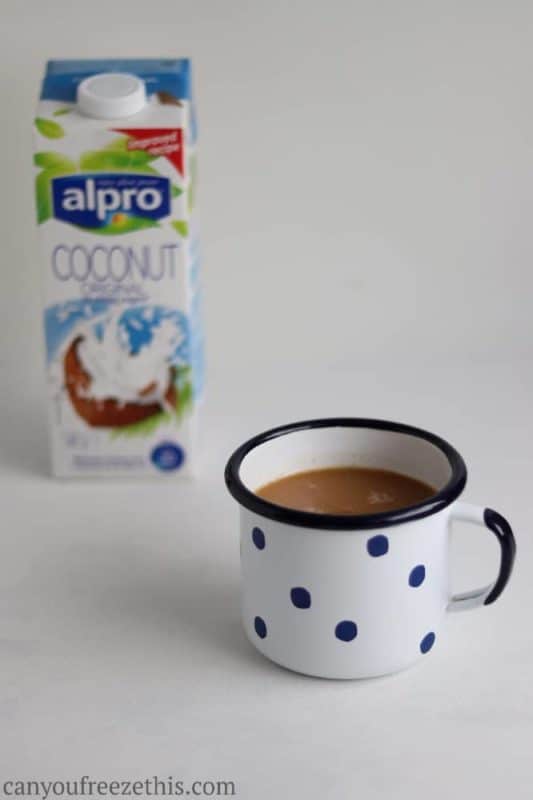
How To Fix Separated Thawed Coconut Milk?
As I already mentioned a couple of times, running the separated coconut milk with a blender is going to bring its consistency back to pretty much normal. It won’t be as good as fresh one, but definitely good enough for using in recipes where the texture of it isn’t the most important thing in the recipe.
For some photos of fresh, thawed, and blended coconut milk visit one of the earlier sections.
How To Use Thawed Coconut Milk?
In case you were wondering about how to use the frozen and defrosted coconut milk, here are a couple of options:
- Coffee whitener
- Baking (cookies, pies, there are hundreds of recipes for lactose intolerant people where coconut milk is used instead of dairy milk)
- Smoothies (coconut milk is often used as a liquid base, but using frozen coconut milk cubes instead of ice cubes is an option too)
- Cooking (pancakes are probably the most popular for the drink variety, and curry for the canned type respectively)
Can You Refreeze Coconut Milk?
Sometimes I feel like most people think refreezing is the worst thing one can do when it comes to food storage and preservation. But in reality, it’s not that bad if you do it correctly. And properly usually means that you either defrost the food in the fridge before refreezing it or cook it through before you freeze it for the second time. The whole point is to prevent or minimize bacterial growth, and either way does a decent job out of it.
Worried that refreezing is not safe? Check out our FAQ.
If you know that you might end up with leftovers from your thawed coconut milk that you won’t be able to use within a day or two, always thaw it in the fridge. This way, you can safely refreeze the rest. Of course, refreezing will make the texture and flavor change even more pronounced, so it’s more like a last resort tool than anything. In other words, for best results, it’s optimal to freeze the liquid only once.
How Long Does Coconut Milk Last?
In general, there are four kinds of coconut milk: sold unrefrigerated, sold refrigerated, canned, and homemade.
The first one is the most popular (when it comes to coconut beverages) because as long as it stays unopened, it lasts for months, and you can store it in the pantry. It usually stays okay for at least a couple of weeks past the date on the label, too. Once you open the bottle or carton, the label usually recommends consuming it within five days, up to maybe a week.
Coconut milk sold refrigerated lasts until the use-by or sell-by date on the label, maybe a couple of days past it. And that date is about a week or two after it’s produced, so its shelf life is limited. Once you open it up, you should use it within a few days.
Canned coconut milk lasts years (observe the date on the label) unopened, and for a few days after opening.
Last but not least, there’s coconut milk you whip up on your own. Depending on whom do you ask, it’s recommended to consume it within 3 to 5 days, as it doesn’t contain any preservatives.
Here’s a quick reference table:
| Pantry | Fridge | |
|---|---|---|
| Coconut milk (sold unrefrigerated, unopened) | Best-by date + 1 – 2 months | |
| Coconut milk (sold unrefrigerated, opened) | 5 – 7 days | |
| Coconut milk (sold refrigerated) | Sell-by date + 3 – 5 days | |
| Coconut milk (homemade) | 3 – 5 days | |
| Canned coconut milk (unopened) | Best-by date + 3 – 6 months | |
| Canned coconut milk (opened) | 3 – 5 days |
So if you already know that you won’t be able to use this nut milk before it goes bad, freezing is probably your only option. Before you get into freezing the liquid, make sure that it’s still okay to drink.
How To Tell If Coconut Milk Is Bad?
Checking whether your nut-milk is spoiled or not is similar for all nut milks. That means it’s pretty much the same for as for almond milk. Here are some of the common signs of expired coconut milk:
- Unopened carton or can is bloated
- Smells off or sour, instead of fresh and coconut-y
- Altered color or discolorations on the surface
- Changed taste (comes down to personal preference, really)
- Lumps or separation of contents (this only applies to fresh coconut milk drink)
Thawed coconut milk will always be separated. Separation in canned coconut milk is also pretty standard and nothing to worry about. Give it a good stir or grab that hand blender for a minute or two and you should be good to go.
References
About the Author

Marcin is the managing editor of CanYouFreezeThis.com. He is making sure all the freezing info on this page is accurate and the posts easy to digest and use.